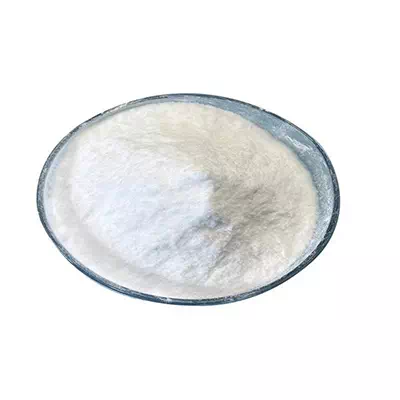

CAS number:23111-00-4
molecular formula:C11H15N2O5.Cl
molecular weight:290.7002
EINECS number:200-184-4
Nicotinamide riboside chloride;Nicotinamide B-D Riboside Chloride(WX900111);Nicotinamide Riboside.Cl;Nicotimide riboside chloride;Pyridinium, 3-(aminocarbonyl)-1-β-D-ribofuranosyl-, chloride (1:1);3-carbamoyl-1-((2R,3R,4S,5R)-3,4-dihydroxy-5-(hydroxymethyl)tetrahydrofuran-2-yl)pyridin-1-ium chloride;3-Carbamoyl-1-(β-D-ribofuranosyl)pyridinium chloride;3-Carbamoyl-1-beta-D-ribofuranosylpyridinium chloride
Pharmaceutical raw materials; nucleosides; finished products; raw materials; commonly used sugar synthesis intermediates; hybridization; pharmaceutical raw material intermediates; coenzyme ribonucleoside nucleic acid series; analytical reagent standard products; coenzyme ribonucleoside nucleic acid series; Acid raw materials; Pharmaceutical and chemical raw materials; Raw materials; Pharmaceutical active molecules; Chemical product raw materials; Product 2; Chemical raw materials; Product;Food additive;NMN;API;1;API-API;Product;Advantageous Compound 1-Crystalline Powder;Impurity Reference Substance;Coenzyme;Organic Raw Material;Spot;Chemical Reagent;23111-00-4;
Nicotinamide riboside is the precursor of nicotinamide adenine dinucleotide (NAD) and represents a source of vitamin B3. Recent research has shown that novel health benefits can be obtained by consuming higher amounts of nicotinamide riboside than naturally found in foods.
Nicotinamide mononucleotide plays an important role in the energy generation of human cells. It participates in the synthesis of NAD (nicotinamide adenine dinucleotide, an important coenzyme for cell energy conversion) in cells.
Storage conditions | under inert gas (nitrogen or Argon) at 2-8°C |
● Nicotinamide riboside has been implicated in increasing tissue NAD concentration and inducing insulin sensitivity and enhancing sirtuin function. Its ability to increase NAD production suggests that nicotinamide riboside may also improve mitochondrial health, stimulate mitochondrial function, and induce the production of new mitochondria. Other studies using nicotinamide riboside in Alzheimer's disease models have shown that this molecule is bioavailable to the brain and may provide neuroprotection by stimulating brain NAD synthesis.
Additionally, a 2012 study observed that mice fed a high-fat diet supplemented with nicotinamide riboside experienced a 60 percent reduction in weight gain compared to mice fed the same high-fat diet without nicotinamide riboside. Nicotinamide riboside chloride (3-carbamoyl-1-[(2R,3R,4S5R)-3,4-dihydroxy-5-(hydroxymethyl)oxolan-2-yl]-pyridine -1-ium chloride; also known as 1-(β-D-ribofuranosyl)nicotinamide chloride) is a known salt form of nicotinamide riboside, although useful salts of nicotinamide riboside and its chloride salts exist properties (e.g. in pharmaceuticals or nutritional supplements), but usually need improvement.
● The residue was transferred back to the 20 L reactor with 7.5 L of methanol. An ice bath was applied to the reactor to adjust the internal temperature to 3°C. On the other hand, 3.75 L (3.75 mol) of 1M NaOCH3 dissolved in methanol was cooled to 3°C, and then this solution was added to the reactor over 10 minutes. During the addition, the internal temperature was kept below 5°C. After the addition was complete, the reaction mixture was stirred for 30 minutes, then 1.25 L (3.75 mol) of 3M HCl was added slowly, keeping the internal temperature below 5°C. At the end of the addition of HCl, the pH=3. Solvent was removed under vacuum. (For convenience, the partially concentrated solution can be stored at 4°C for up to 48h). After complete concentration, the residue can be stored at -20°C for up to 18h. To remove residual methanol, the evaporation residue was dissolved in water and concentrated under vacuum (3x1 L). The residue was taken up in 5 L of water and the pH was adjusted to 4 with 2M NaOH(aq). Sodium chloride (NaCl) was added to the solution, and the mixture was stirred at room temperature until the NaCl was saturated, leaving about 5 g of undissolved NaCl.
The saturated solution was extracted with tetrahydrofuran (THF, 3x5L). The aqueous layer was monitored by 1H NMR to confirm that acetic acid had been removed after extraction was complete. The aqueous phase was adjusted to pH = 6-7 with 2M NaOH(aq), then extracted with THF (4x5L). The aqueous layer was monitored by 1H NMR to confirm that residual nicotinamide was <5 mol% relative to nicotinamide riboside. The absence of triflate in the aqueous layer was also confirmed using 19FNMR. The aqueous layer was then concentrated under vacuum to remove 2.5 L of water. The residual suspension was diluted with 5 L of ethanol, filtered, and the salt precipitate was washed with 2.5 L of ethanol. The combined filtrate and washings were concentrated in vacuo to a thick oil. This was stirred with 1.5 L of methanol, the precipitate was filtered, and the solution was concentrated under vacuum. The residue was stirred with an additional 1.5 L of methanol, the precipitate was filtered and the solution concentrated in vacuo. The residue was stirred with a third 1.5 L portion of methanol, the precipitate was filtered and the solution concentrated in vacuo to give 385 g of an orange-red oil. The amount of residual methanol was confirmed to be 34 g by 1H NMR, and the crude product yield was 351 g (77%). THF extraction was used to remove most of the excess nicotinamide.
Sales hotline:

 Scan and consult wechat customer service
Scan and consult wechat customer service